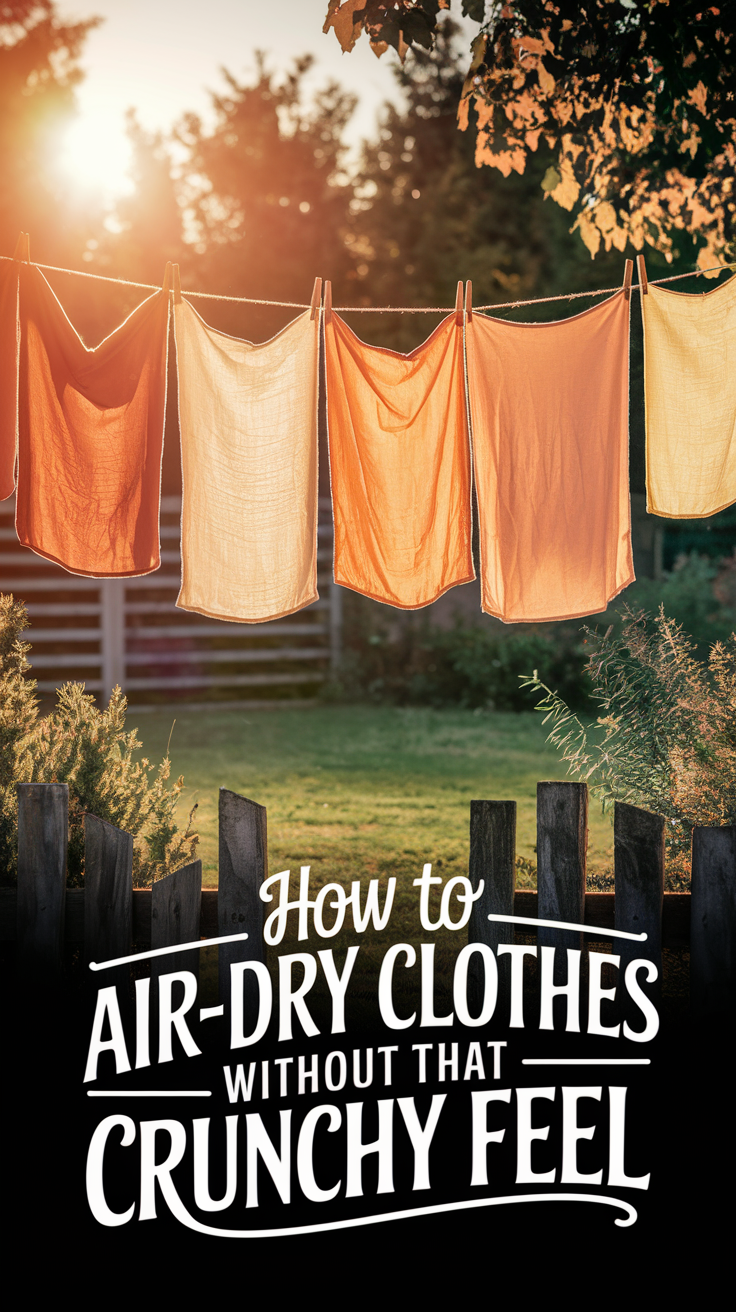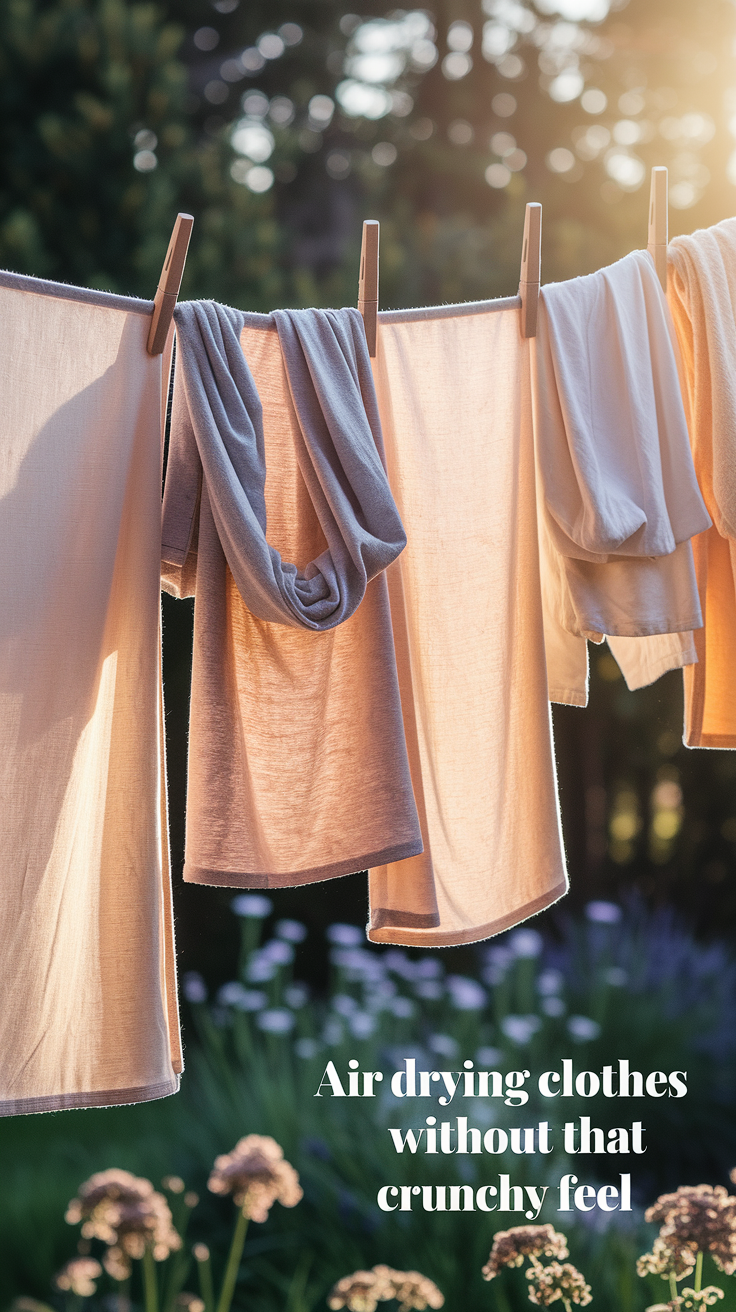
Your yearly home energy costs will decrease by over $100 by using air-drying instead of machine drying. The major drawback of line-drying your laundry remains the stiff feeling in garments, which persuades numerous individuals to avoid this method. Sound familiar?
Readers who suffer from wearing stiff, dry-clothed shirts should find valuable information in this guide. This article demonstrates how to achieve smooth air-dried laundry by combining professional methods and household ingredients with small laundry process reforms. The discussion will explain the reasons for stiffness by examining fabric and water factors and present alternative methods for achieving fresh, soft laundry instead of dryer dependence.
Which groups constitute the primary audience for this guide?
All house owners who dry their clothes outside the building will access beneficial information through this guide. This guide is particularly beneficial for renters, students, small-space dwellers, off-grid households, and eco-conscious families.
Why Do Air-Dried Clothes Feel Crunchy?
The stiffness of laundry that dries outside does not match up with typical detergent usage. The main issue stems from failures of both machine tumbling and more profound issues.
- Hard water is a major factor. It contains minerals like calcium and magnesium that cling to fabric fibers. Once the water evaporates, those minerals stay behind—making the fabric feel rough or “crunchy.”
- Excess detergent or fabric softener residue can also lead to stiffness. Without the agitation and rinsing power of a dryer, residues stay trapped in the fibers.
- Environmental conditions—like direct sun, strong wind, or very dry air—can cause clothes to overdry. When moisture is pulled out too quickly, fibers stiffen and become brittle.
- Poor airflow or improper hanging (like leaving clothes bunched up) can cause uneven drying, leading to that undesirable crispness in certain areas.

Which Fabrics Are Most Prone to Crunchiness?
Each fabric material shows unique reactions when left to air dry. The identification of fabric types which are more sensitive helps you plan your drying process effectively.
Natural Fibers vs. Synthetic Materials
- Cotton and linen are especially prone to stiffness when air-dried, particularly in dry or windy conditions. They absorb more water and are more reactive to mineral buildup.
- Wool can feel crunchy if dried too quickly or in sunlight but is generally softer when dried flat indoors.
- Synthetic blends like polyester or rayon dry faster and tend to retain a softer texture—but they may feel “static-y” or clingy instead.
Caring for Specific Fabrics
- Towels, sheets, and jeans are common culprits for roughness due to thickness and fiber density.
- Undergarments, t-shirts, and light knits are easier to manage and maintain softness.
- Prepping fabrics with the right spin cycle or wash additives makes a huge difference.
How to Prep Laundry Before Air Drying
Soft results start in the wash cycle, not the drying stage. Here’s how to get your fabrics ready for a softer finish:
Detergents and Additives
- Use less detergent. Really. Most people use double what’s needed, leaving residue behind.
- Skip commercial fabric softeners—they coat the fibers and reduce absorbency, especially for towels.
- Add white vinegar (1/4 cup) during the rinse cycle to naturally soften fibers and eliminate detergent buildup.
- Try baking soda in the wash to neutralize minerals and odors.

Spin It Right
- Use a medium spin speed to avoid overdrying the fabric in the washer.
- Over-spinning can leave the fabric too stiff when line-dried, especially for delicates or lightweight items.
Line-Drying Techniques That Make a Difference
The method you use when hanging your clothes results in either precise or irreparable texture issues on the garments.
Proper Hanging Techniques
- Shake clothes out vigorously before hanging—this helps loosen fibers and prevents wrinkles.
- Hang shirts and dresses on padded hangers to preserve shape and reduce shoulder bumps.
- Clip heavy fabrics by the hems rather than the waistband to avoid stiff waistlines.
- Avoid overlapping garments—give each item space for airflow.
Where and When to Dry for Best Results
Most individuals would underestimate the extent to which environmental conditions affect the drying process. The drying duration requires readjustment since the present time and speed combinations may be inappropriate.
Best Conditions for Drying
- Shaded, breezy areas are ideal. Wind helps remove moisture evenly without baking the fabric.
- Avoid direct sunlight for long periods—it overdries fabric and causes fading.
- Dry indoors during extreme heat or cold; use a drying rack near an open window or fan.

Timing Is Key
- Remove clothes from the line when they’re 90–95% dry, then air-finish indoors—this prevents over-drying.
- Misting slightly stiff clothes before bringing them in can help reactivate the fibers and restore softness.
Smart Tricks to Keep Fabrics Soft Naturally
Let’s talk hacks. Several basic and low-cost techniques help advance your laundry operations without major efforts.
Softness Boosters That Actually Work
- Throw a dry towel in the basket with freshly dried clothes—it absorbs extra stiffness.
- Roll damp items in a clean towel and press gently—works great for delicate fabrics.
- Tumble for 5 minutes (if you have a dryer) with dryer balls for a quick softening effect—no heat needed!
- Use essential-oil sprays (lavender + vinegar mix) to refresh and soften at once.
Quick Reference: What Helps or Hurts Fabric Softness
| Action / Factor | Impact on Softness | Expert Tip |
|---|---|---|
| Adding vinegar to rinse | ✅ Softens fibers | Use ¼ cup per load |
| Overdosing on detergent | ❌ Causes stiffness | Use half the recommended dose |
| Drying in direct sun | ❌ Increases crunch | Opt for shade or indirect sunlight |
| Shaking clothes before drying | ✅ Reduces stiffness | Do it after every wash |
| Air-drying indoors with airflow | ✅ Preserves softness | Use a fan or open window |
Common Mistakes to Avoid

Different types of potential mistakes can occur even among experienced home launderers when they wash their clothes. Observe the following points with due caution during the drying process:
- Overloading the drying line—less airflow means uneven and slower drying.
- Leaving clothes for too long can cause the fibers to become brittle once they are bone-dry.
- Skipping the shake—a quick shake loosens the weave and keeps clothes flexible.
- Using hard water without treatment—invest in a simple softener or vinegar rinse.
Latest Trends in Air-Drying (2025 Update)
The year 2025 marks the unification of sustainability and convenience within laundry facilities. Here’s what’s trending now:
- Ionic fabric refreshers: Portable plug-in devices that soften and deodorize clothes while they dry.
- Vertical drying systems: Space-saving racks with built-in airflow circulation.
- Natural fabric sprays with aloe or oat extracts that soften fibers without coating them.
- Laundry line design: Retractable indoor/outdoor systems that adjust height and airflow based on the season.
Conclusion: Air-Dry Soft, Save More
The manufacturing of soft, comfortable clothing does not need any dryers. Knowledge about how water behaves with different fabrics in particular drying environments will let you develop new drying habits that produce much better results for air-dried clothes.
🧼 Key takeaways:
- Always shake clothes out before drying.
- Use vinegar in the rinse cycle instead of fabric softener.
- Avoid direct sun and overdrying; your best friends are shade and airflow.
- Don’t overdose on detergent; use soft water when possible.
- Mist or steam lightly for a finishing touch if needed.
Please provide your drying procedure for clothes that use open-air methods. What procedure do you adopt to dry your clothes when heat tools are forbidden? Which method do you use for delicate fabrics?
We would appreciate your drying techniques, which you can share through comments.
📲 Found the information helpful? You have the option to send the piece to your friends or save it for a future laundering session.
Users can find the sharing options under the Buttons section, which includes Share on Facebook, Tweet This, and Send via Telegram.

